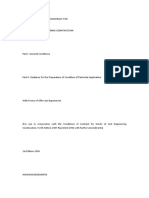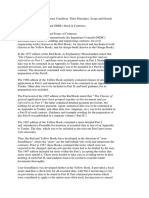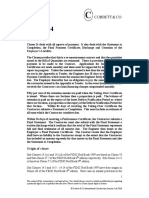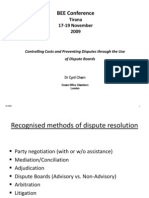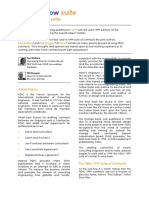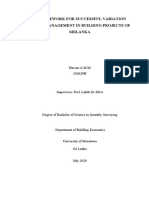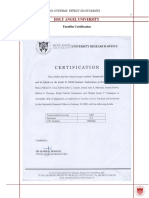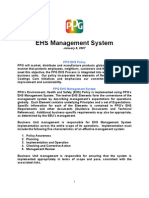The Allocation of Risk in Fidic Part I
The Allocation of Risk in Fidic Part I
Uploaded by
musthaqhassanCopyright:
Available Formats
The Allocation of Risk in Fidic Part I
The Allocation of Risk in Fidic Part I
Uploaded by
musthaqhassanOriginal Description:
Original Title
Copyright
Available Formats
Share this document
Did you find this document useful?
Is this content inappropriate?
Copyright:
Available Formats
The Allocation of Risk in Fidic Part I
The Allocation of Risk in Fidic Part I
Uploaded by
musthaqhassanCopyright:
Available Formats
THE ALLOCATION OF RISK
IN FIDIC (PART I)
An introduction to the allocation of risk
under FIDIC from a Danish perspective
INTRODUCTION
In any construction project, uncertain events
will likely occur, which will have an effect on the
achievement of the projects’ objectives, such as
time, money and quality. Such uncertain events
in construction projects commonly include un-
expected ground conditions, inadequate plans,
delays, weather conditions, inadequate spec-
ifications, faulty materials or workmanship,
extra work etc. and risks related to such events
should always be foreseen, managed and allo-
cated in the construction contract.
When allocating such risks, the following four
questions are relevant to ask and assess:
• Which party can best foresee the risk?
• Which party can best control the risk and
associated consequences? Silver book in 1999 until the second edition in
• Which party can best bear that risk, e.g. 2017, the provision was renamed from “Force
can a party transfer the risk, e.g. through Majeure” to now “Exceptional Events”. Experi-
insurance? ence had shown that the practical use of “Force
Majeure” was under certain circumstances
• Which party ultimately most suffers or challenging and unclear, as force majeure is a
benefits when the risk eventuates? legal standard with different meanings from
The responses to these questions are reflected jurisdiction to jurisdiction. What constitutes
in FIDIC, and in the below short paper, we will force majeure in the country of the employer,
assess how the Fédération Internationale Des may not constitute force majeure in the coun-
Ingénieurs-Conseils (FIDIC) have decided to al- try of the contractor.
locate the risk between contractor and employ- Consequently, the term “Exceptional Events”
er relating to force majeure, unforeseen ground was implemented and defined as an event or
conditions and change in law1. Focus will be on circumstance which (i) is beyond a party’s
the FIDIC Red (Construction Contract), Yellow control, (ii) the party could not reasonably
(Design and Build) and Silver (Turnkey/EPC) have provided against at contract award and
books2. (iii) having arisen, the party could not reason-
ably have avoided or overcome. This definition
FORCE MAJEURE/ corresponds to the definition of force majeure
under Danish law. Furthermore, a non-exhaus-
EXCEPTIONAL EVENTS tive list of possible Exceptional Events was im-
plemented in Clause 18 stating events such as
An uncertain event, which may arise during a
war, terrorism, riot, strikes, lockout and natural
construction project, and which may have an
catastrophes. It is noted that the list does not
impact on both time, money and quality, is the
include epidemics or pandemics.
force majeure event, which particularly has be-
come relevant following the Covid-19 pandem- If a party can prove that an event constitutes
ic. The allocation of risk related to such force an Exceptional Event, as defined above, and
majeure event is regulated in Clause 18 of the the party in fact and consequently is prevent-
FIDIC Red, Yellow and Silver Book. ed from performing its contractual obligations,
the party is excused performance of its obli-
From the first edition of the Red, Yellow and
1 It is noted that in Part II of our Insight on the allocation of risk in FIDIC, we will also assess FIDIC’s risk
allocation connected to performance guarantee, indemnification and insurance.
2 For further information on the application of the FIDIC Red, Yellow and Silver Book, see https://plesner.
com/speciale/construction%20law/fidic?sc_lang=en
Page 01 | Plesner Insight, The allocation of risk in FIDIC (Part I)
gations, while prevented from doing so. If the the question is, who shall bear the risk of such
affected party is the contractor, the contractor change.
may be entitled to further relief in the form of
Under FIDIC3 , if the costs of the contractor in-
an extension of time and/or, in limited circum-
crease or decrease due to a change in (i) the
stances, additional payment.
laws of the country, in which the works are per-
FIDIC does not deal with the situation, where formed, (ii) the interpretation of such laws, or
the affected party is the employer. Most of (iii) any permit, permission or license obtained
the risks associated with Exceptional Events by the employer or contractor, the contract
are thus allocated to the employer, as a risk he price shall be adjusted. In this respect, “costs”
must bear. However, the contractor’s share of shall be understood as the expenditures rea-
the hardship associated with Exceptional Events sonably incurred by the contractor in perform-
is limited to only being entitled to claim the di- ing the contract.
rect expenditure reasonable incurred in certain
With respect to the delay risk, the contractor
specified events as set out in Clause 18.4(b),
may be entitled to an extension of time, if the
and thus not any indirect costs, such as loss of
contractor can demonstrate that such change
profit. You could say that the risk has been part-
in law has caused a delay.
ly shared.
The majority of the risks associated with a
Compared to Danish construction law, this
change in law are thus allocated to the employ-
can, however, not be seen as a hardship on the
er. However, compared to the 1999 edition, the
contractor, as under the Danish general condi-
2017 edition of the Red, Yellow and Silver book
tions for building and construction works and
has now opened up for the possibility that a
supplies, AB18, the contractor would only be
change in law not only entitles the contractor
entitled to an extension of time in case of force
to an increase of the contract price, but also
majeure, and thus not any compensation.
the employer to a decrease, if the change in law
causes a decrease in the contractor’s costs.
Under Danish construction law, a similar risk al-
location applies in case of change in law.
UNFORESEEN GROUND
CONDITIONS
The risk of unforeseen ground conditions is well
known in the construction industry and the ef-
fects can often be felt in terms of both time and
money. Certain types of work are more likely
to be affected by ground conditions, however,
as most structures have subsoil foundations of
some kind, the principle of unforeseen ground
conditions is generally applicable. Accordingly,
the risk of potential time and cost consequenc-
es should be provided for and considered in
every construction contract.
CHANGE IN LAW In FIDIC Red and Yellow book, the issue of un-
foreseen ground conditions is dealt with under
Under a construction contract, the parties
the heading “Unforeseeable Physical Condi-
must perform their obligations in compliance
tions”4. This term extends to apply to natural
with the applicable laws. If such laws change
physical conditions and physical obstructions
during the term of the construction contract,
(natural or man-made) and pollutants, which
3 Clause 13.6
4 Clause 4.12
Page 02 | Plesner Insight, The allocation of risk in FIDIC (Part I)
the contractor encounters at the site during ex- the effect is that no addition to the contract
ecution of the work, including sub-surface and price is payable7. The delay risks are not nec-
hydrological conditions, but excluding climat- essarily allocated to the contractor, in case of
ic conditions and the effects of those climate unforeseen ground conditions, as an extension
conditions. The physical conditions must be of time under certain circumstances may be en-
“Unforeseeable”, which means that it must not titled.
be reasonably foreseeable by an experienced
Under Danish construction law, similar prin-
contractor by the date 28 days before the latest
ciples apply, in the sense that if a contractor
date for submission of the contractor’s tender5.
can demonstrate that ground conditions are
If the contractor can demonstrate that the unforeseen, and these conditions lead to de-
physical conditions were “Unforeseeable”, and lay and/or increased costs, the contractor may
that the contractor consequently has suffered be granted an extension of time as well as
delay and/or incurred costs, the contractor may compensation for costs. When assessing the
be granted an extension of time as well as com- risk allocation under Danish law, emphasis is,
pensation for costs related to any delay or, if however, put on (i) whether the employer has
appropriate, costs incurred due to the physical fulfilled his duty to loyally disclose information
conditions6. on ground conditions in the tender documents
and (ii) whether the contractor has fulfilled his
The unforeseeability test is decisive for deter-
duty of inspection. If the unforeseen ground
mining the risk allocation for ground condi-
conditions are beyond what a contractor rea-
tions and other physical conditions under the
sonably can expect, when reviewing the tender
FIDIC Red and Yellow book. When applying this
documents, the employer will likely bear the
test, the following three principles must be
risk of such unforeseen ground conditions, thus
considered:
leading to an entitled claim for extension of
1. The test is not what was actually foreseea- time and costs for the contractor.
ble, but what would have reasonably been
foreseeable
2. The foreseeability is not that of the specific
contractor, but of an experienced contrac-
tor
3. The point in time to which the test refers
is the date 28 days before the submission
of the contractor’s tender, meaning that
it must be seen together with the infor-
mation available to the contractor and the
correctness and sufficiency of such infor-
mation.
In FIDIC Sliver book, which concerns EPC/turn-
key, the issue of unforeseen ground conditions
is also dealt with under the heading “Unfore-
seen Physical Conditions”. Compared to the
Red and Yellow book, the Silver book presents
a more thorough ongoing allocation of ground
risk. Under Clause 4.12, the Contractor bears
the risk of unforeseen ground conditions and
5 Clause 1.1.85 in Red book and Clause 1.1.87 in Yellow book
6 Clause 4.12.4
7 Nevertheless, if the unforeseen ground conditions relates to archaeological and geological findings
(Clause 4.23), remedial work (Clause 7.6), variations (Clause 13.3.2), changes in laws (Clause 13.6)
or exceptional events (Clause 18.3), the contractor may be entitled to payment for compensation
for difficulties encountered.
Page 03 | Plesner Insight, The allocation of risk in FIDIC (Part I)
CONTACT
Read more about
Plesner’s Construction
team at plesner.com
Peter Fogh Niklas Korsgaard Christensen
Attorney-at-Law, Partner Attorney-at-Law, Partner, MBA
pfo@plesner.com nkc@plesner.com
D: +45 36 94 13 59 D: +45 36 94 12 39
M: +45 21 65 09 11 M: +45 30 93 71 35
Anne-Sophie Bundesen Frederik Lenskjold Olsen Frederik Leth Keller
Attorney-at-Law, Director Attorney-at-Law, Manager Attorney-at-Law
atr@plesner.com flo@plesner.com fke@plesner.com
D: +45 36 94 13 33 D: +45 36 94 15 51 D: +45 36 94 13 27
M: +45 29 99 30 13 M: +45 29 99 30 77 M: +45 30 62 59 43
Page 04 | Plesner Insight, The allocation of risk in FIDIC (Part I)
Plesner Advokatpartnerselskab | Amerika Plads 37 | DK-2100 Copenhagen | Tel +45 33 12 11 33 | www.plesner.com
You might also like
- Rics Apc Study Guide Quantity Surveying 2024Document306 pagesRics Apc Study Guide Quantity Surveying 2024musthaqhassanNo ratings yet
- 2016-FIDIC-蓝皮书- Dredging and Reclamation Works (2016)Document20 pages2016-FIDIC-蓝皮书- Dredging and Reclamation Works (2016)tt_xyfNo ratings yet
- GRJ 3319Document8 pagesGRJ 3319Devendra Rai100% (1)
- Safe Mooring PracticeDocument84 pagesSafe Mooring PracticeVesa Mihai100% (11)
- Sample Research ProtocolDocument5 pagesSample Research Protocollpolvorido100% (1)
- A Contractor's Guide to the FIDIC Conditions of ContractFrom EverandA Contractor's Guide to the FIDIC Conditions of ContractNo ratings yet
- The NEC4 Engineering and Construction Contract: A CommentaryFrom EverandThe NEC4 Engineering and Construction Contract: A CommentaryNo ratings yet
- Risk Assessment For Use of Power ToolsDocument2 pagesRisk Assessment For Use of Power ToolsRicardo Dalisay100% (5)
- Delay in StartUp InsuranceDocument2 pagesDelay in StartUp Insurancemusthaqhassan100% (1)
- SIP 2023 2028 TemplateDocument66 pagesSIP 2023 2028 TemplateJOSEVIE CABISAY100% (6)
- Fidic Module 1 International Training ProgrammeDocument2 pagesFidic Module 1 International Training ProgrammeakanagesNo ratings yet
- FIDIC Article Christopher R Seppala Article - ReworkedDocument22 pagesFIDIC Article Christopher R Seppala Article - ReworkedSivakumar KandasamyNo ratings yet
- 3 - Dr. Ahmed Waly - Drafting Particular Conditions For Construction ContractsDocument6 pages3 - Dr. Ahmed Waly - Drafting Particular Conditions For Construction ContractsHema Chandra Indla100% (1)
- Cornes and Lupton's Design Liability in the Construction IndustryFrom EverandCornes and Lupton's Design Liability in the Construction IndustryNo ratings yet
- The New Fidic 2017 Yellow Book What You Need To KnowDocument4 pagesThe New Fidic 2017 Yellow Book What You Need To KnowMohanna Govind100% (1)
- Clyde Co - FIDIC Red Book 2017 - A MENA Perspective FINALDocument8 pagesClyde Co - FIDIC Red Book 2017 - A MENA Perspective FINALkarlosgwapo3No ratings yet
- Article Differences FIDIC - OrgalimeDocument18 pagesArticle Differences FIDIC - OrgalimepapillonnnnNo ratings yet
- FIDIC Changes in Harmonized Edition (1999 Edition)Document37 pagesFIDIC Changes in Harmonized Edition (1999 Edition)reezaNo ratings yet
- Condition of Subcontract For Works of Civil Engineering ConstructionDocument61 pagesCondition of Subcontract For Works of Civil Engineering ConstructionsandywhgNo ratings yet
- Dispute Review Boards and Adjudication EtcDocument25 pagesDispute Review Boards and Adjudication EtcGeri StoqnovaNo ratings yet
- FIDIC Guidance On Enforcing DAB DecisionsDocument3 pagesFIDIC Guidance On Enforcing DAB DecisionshaneefNo ratings yet
- DAAB ResearchDocument34 pagesDAAB ResearchAmer Hdaib100% (1)
- Clause-20 Fidic 1999 - Complete NarrativeDocument55 pagesClause-20 Fidic 1999 - Complete NarrativeUsmanNo ratings yet
- Time Bars and Their Enforceability in English Law EPC ContractsDocument3 pagesTime Bars and Their Enforceability in English Law EPC ContractsMuhammad TalhaNo ratings yet
- Sub Clause 1.15 Limitation of Liability PDFDocument4 pagesSub Clause 1.15 Limitation of Liability PDFBogdanNo ratings yet
- The Four FIDIC 1999 Contract ConditionDocument18 pagesThe Four FIDIC 1999 Contract Conditionsandu2007No ratings yet
- Prolongation Costs - A Non Global ApproachDocument4 pagesProlongation Costs - A Non Global Approachpatrick100% (1)
- Fidic Slides Jeremy GloverDocument18 pagesFidic Slides Jeremy GloverAlan WhaleyNo ratings yet
- FIDIC ContractDocument31 pagesFIDIC ContractHealy45No ratings yet
- FIDIC - Base Line QuestionnaireDocument3 pagesFIDIC - Base Line Questionnairevamshi.nNo ratings yet
- One Step Forward Two Steps Backward A Critical Review of The FIDIC Conditions of Contract For PlantDocument24 pagesOne Step Forward Two Steps Backward A Critical Review of The FIDIC Conditions of Contract For PlantpieremicheleNo ratings yet
- Fidic Exp PDFDocument34 pagesFidic Exp PDFGaminiNo ratings yet
- FIDIC Red Book A CommentaryDocument389 pagesFIDIC Red Book A Commentaryyuanchaojie12No ratings yet
- FIDIC Claim ManagementDocument6 pagesFIDIC Claim ManagementMark GraystonNo ratings yet
- Termination of The Contract Under FIDIC The PerspeDocument20 pagesTermination of The Contract Under FIDIC The Perspeteed100% (1)
- Diffrence 1987 and 1999 Fidic PDFDocument49 pagesDiffrence 1987 and 1999 Fidic PDFTaseer BuchhNo ratings yet
- FIDIC COVID-19 Guidance MemorandumDocument14 pagesFIDIC COVID-19 Guidance Memorandumhz135874100% (1)
- Yellow Book - ProceudresDocument3 pagesYellow Book - ProceudresmohammedNo ratings yet
- FIDIC Short Form Cover & ContentsDocument10 pagesFIDIC Short Form Cover & ContentsNavneet SinghNo ratings yet
- Introduction To FIDIC Dispute Adjudication Board Provisions (Owen - 2004)Document61 pagesIntroduction To FIDIC Dispute Adjudication Board Provisions (Owen - 2004)shady_sherif100% (3)
- FIDIC: Termination by The Employer Under The Red and Yellow BooksDocument8 pagesFIDIC: Termination by The Employer Under The Red and Yellow BookssaihereNo ratings yet
- FIDIC Rainbow Suite-First 4 ArticlesDocument30 pagesFIDIC Rainbow Suite-First 4 ArticlesbkarabasevicNo ratings yet
- Table of FIDIC Cases - 03 July 2023 UpdateDocument51 pagesTable of FIDIC Cases - 03 July 2023 Updatedbrooksutt100% (1)
- Introduction To FIDIC's New Yellow Book Contract 2017Document52 pagesIntroduction To FIDIC's New Yellow Book Contract 2017natasatkNo ratings yet
- Commentary:: Amending Clause 13.1 of FIDIC - Protracted NegotiationsDocument2 pagesCommentary:: Amending Clause 13.1 of FIDIC - Protracted NegotiationsArshad MahmoodNo ratings yet
- Contract Indian Vs FidicDocument12 pagesContract Indian Vs FidicPritam MondalNo ratings yet
- Contractual Time FramesDocument3 pagesContractual Time Framestniazi8784No ratings yet
- COMMENT 2012 Slides FidicDocument78 pagesCOMMENT 2012 Slides FidicpapillonnnnNo ratings yet
- Fidic Red Book 2017 - A Mena PerspectiveDocument8 pagesFidic Red Book 2017 - A Mena PerspectiveDavid MorgadoNo ratings yet
- Analysis of English Construction LawDocument53 pagesAnalysis of English Construction LawMcraigNo ratings yet
- Ronan Champion - Hudson Formula Death by FootnoteDocument14 pagesRonan Champion - Hudson Formula Death by FootnoteNebojsa PavlovicNo ratings yet
- Between A Lump Sum and Cost Plus Contracts...Document1 pageBetween A Lump Sum and Cost Plus Contracts...Chelle Sujetado De GuzmanNo ratings yet
- Covid 19 and NEC4 - 1Document2 pagesCovid 19 and NEC4 - 1Jesh SawNo ratings yet
- Risk Allocations in Construction ContractsDocument10 pagesRisk Allocations in Construction ContractsMdms PayoeNo ratings yet
- Price List - Fidic DocumentsDocument3 pagesPrice List - Fidic DocumentsShahnawaz AzizNo ratings yet
- Increased Size: FIDIC Redbook 2017 Vs 99 - Top 11 ChangesDocument3 pagesIncreased Size: FIDIC Redbook 2017 Vs 99 - Top 11 ChangesDangi DilleeRamNo ratings yet
- BEE Conference: Tirana 17-19 November 2009Document31 pagesBEE Conference: Tirana 17-19 November 2009andorginderNo ratings yet
- Flow Chart Under Fidic 1999Document3 pagesFlow Chart Under Fidic 1999yousefNo ratings yet
- Five-Golden Principles of FIDICDocument4 pagesFive-Golden Principles of FIDICMintesnot Bogale100% (1)
- Case Laws Related To Fidic - Glen DharshanDocument23 pagesCase Laws Related To Fidic - Glen Dharshanmufrith 123No ratings yet
- The Five Golden Principles (FIDIC's Protection of Genuinity)Document6 pagesThe Five Golden Principles (FIDIC's Protection of Genuinity)Anonymous pGodzH4xLNo ratings yet
- Contract Assignment FinalDocument22 pagesContract Assignment FinalSujay Yeole100% (1)
- FidicDocument44 pagesFidicvanja podhradskiNo ratings yet
- Multi-Party and Multi-Contract Arbitration in the Construction IndustryFrom EverandMulti-Party and Multi-Contract Arbitration in the Construction IndustryNo ratings yet
- Handbook of Contract Management for Construction professionals as per FIDICFrom EverandHandbook of Contract Management for Construction professionals as per FIDICRating: 5 out of 5 stars5/5 (1)
- AACE 29R03 Delay Analysis MethodologiesDocument4 pagesAACE 29R03 Delay Analysis MethodologiesmusthaqhassanNo ratings yet
- Progress Reporting Procedure (Template)Document8 pagesProgress Reporting Procedure (Template)musthaqhassanNo ratings yet
- Frequently Asked Questions - Workers Compensation Insurance-3Document8 pagesFrequently Asked Questions - Workers Compensation Insurance-3musthaqhassanNo ratings yet
- 25 Hacks To Win As A Young Construction ProfessionalDocument26 pages25 Hacks To Win As A Young Construction ProfessionalmusthaqhassanNo ratings yet
- Pre-Qualification Questionnaire Main ContractorDocument28 pagesPre-Qualification Questionnaire Main Contractormusthaqhassan100% (1)
- CPD Framework Consultation Document April 2024Document14 pagesCPD Framework Consultation Document April 2024musthaqhassanNo ratings yet
- Past Papers - Proffesional CommnicationDocument17 pagesPast Papers - Proffesional CommnicationmusthaqhassanNo ratings yet
- Cut and FillDocument4 pagesCut and FillmusthaqhassanNo ratings yet
- Interim Payment Application-3 220KV Switching Station Project KerawalapitiyaDocument1 pageInterim Payment Application-3 220KV Switching Station Project KerawalapitiyamusthaqhassanNo ratings yet
- Cover Page BDocument1 pageCover Page BmusthaqhassanNo ratings yet
- Variation Schedule 13.11.2020Document7 pagesVariation Schedule 13.11.2020musthaqhassanNo ratings yet
- Citations: Rules For In-Text Citing in APA StyleDocument10 pagesCitations: Rules For In-Text Citing in APA StylemusthaqhassanNo ratings yet
- 1Document2 pages1musthaqhassanNo ratings yet
- Lecture SlidesDocument21 pagesLecture SlidesmusthaqhassanNo ratings yet
- Professional Ethics Construction Econ Research Methodology 9-Jul 25-Jun PW 9-Jul 10-Jul Lec 16-Jul Lec 18-Jul PWDocument2 pagesProfessional Ethics Construction Econ Research Methodology 9-Jul 25-Jun PW 9-Jul 10-Jul Lec 16-Jul Lec 18-Jul PWmusthaqhassanNo ratings yet
- Tender Documentation - PresentationDocument34 pagesTender Documentation - PresentationmusthaqhassanNo ratings yet
- Professional Negligence FinalDocument56 pagesProfessional Negligence FinalmusthaqhassanNo ratings yet
- Upac - Vo - 01Document1 pageUpac - Vo - 01musthaqhassanNo ratings yet
- Process Flow Chart For Subcontractor SelectionDocument1 pageProcess Flow Chart For Subcontractor SelectionmusthaqhassanNo ratings yet
- Session Presentation 02 - (IPES-QS-T01 Estimating and Tendering)Document21 pagesSession Presentation 02 - (IPES-QS-T01 Estimating and Tendering)musthaqhassanNo ratings yet
- What Are Liquidated Damages in Construction Contracts - Sihela ConsultantsDocument10 pagesWhat Are Liquidated Damages in Construction Contracts - Sihela ConsultantsmusthaqhassanNo ratings yet
- Revised Project Study IV BriefDocument19 pagesRevised Project Study IV BriefmusthaqhassanNo ratings yet
- Interim Payment ? Correct Name ?: Webinar: Preparation O F Interim Valuation Session Id: Ip&Es-Qs-T05Document9 pagesInterim Payment ? Correct Name ?: Webinar: Preparation O F Interim Valuation Session Id: Ip&Es-Qs-T05musthaqhassanNo ratings yet
- Knowledge Library On Past ProjectsDocument1 pageKnowledge Library On Past ProjectsmusthaqhassanNo ratings yet
- "Delay Analysis Methods: Which One To Use?": Technical SessionDocument31 pages"Delay Analysis Methods: Which One To Use?": Technical Sessionmusthaqhassan100% (1)
- DRR Quarter 3 Week 1Document6 pagesDRR Quarter 3 Week 1Shastine ClaorNo ratings yet
- CRM Documentation: Date Prepared: Prepared By: Release No: Application NameDocument12 pagesCRM Documentation: Date Prepared: Prepared By: Release No: Application Nameapi-137303031No ratings yet
- BUSINESS RESEARCH REPORT EditDocument41 pagesBUSINESS RESEARCH REPORT EditARUN MAURYANo ratings yet
- Pracres Group 4 FinalDocument66 pagesPracres Group 4 FinalMICHELLE BIANCA PATRICE CRUZNo ratings yet
- Compendium Petitioner AnonymousDocument105 pagesCompendium Petitioner Anonymouspratham mohantyNo ratings yet
- Managing Business Process Outsourcing JUNE 2022Document12 pagesManaging Business Process Outsourcing JUNE 2022Rajni KumariNo ratings yet
- Logical Framework and Project Proposal 119679674017067 2Document75 pagesLogical Framework and Project Proposal 119679674017067 2Vaibhav Pandey100% (1)
- Es312 Economics 4 5 6Document24 pagesEs312 Economics 4 5 6Vhence BelandresNo ratings yet
- BSC Fire SafetyDocument1 pageBSC Fire Safetyrajkamal rNo ratings yet
- Process Safety Management OutlineDocument24 pagesProcess Safety Management Outlineismailines100% (1)
- EHS Management SystemDocument15 pagesEHS Management SystemPriti Tuteja0% (1)
- Session 05 Vulnerability AssessmentDocument33 pagesSession 05 Vulnerability AssessmentNicholas WhiteNo ratings yet
- Rapid Risk AssessmentDocument123 pagesRapid Risk AssessmentK. ManjericãoNo ratings yet
- Final Book of AbstractDocument116 pagesFinal Book of AbstractPär S100% (1)
- Back Ground Climate RiskDocument2 pagesBack Ground Climate RiskHaccee TubeNo ratings yet
- Amanue Lhaile PDFDocument70 pagesAmanue Lhaile PDFkaleb100% (1)
- ADA Caries Risk Assessment Form Completion Instructions: Over 6 YearsDocument7 pagesADA Caries Risk Assessment Form Completion Instructions: Over 6 Yearsovy primaNo ratings yet
- The Peak HiLo IndicatorDocument10 pagesThe Peak HiLo IndicatorRonald DubeNo ratings yet
- F. Training Plan in Dressmaking NC IIDocument8 pagesF. Training Plan in Dressmaking NC IIRYDENNo ratings yet
- Osh Case Study 1Document3 pagesOsh Case Study 1Fikri ZulkapliNo ratings yet
- NSC-400-CE-3110-MOS-02-A-Method Statement For 69kV Transmission Pole ErectionDocument18 pagesNSC-400-CE-3110-MOS-02-A-Method Statement For 69kV Transmission Pole ErectionElisco Pher SalmasanNo ratings yet
- Psychology and Marketing - 2021 - Kim - When Do You Trust AI The Effect of Number Presentation Detail On Consumer TrustDocument16 pagesPsychology and Marketing - 2021 - Kim - When Do You Trust AI The Effect of Number Presentation Detail On Consumer TrustEmilio CruzNo ratings yet
- VDSFVSDFGVSDFGSFGSFSFSFSF PDFDocument9 pagesVDSFVSDFGVSDFGSFGSFSFSFSF PDFKomal SharmaNo ratings yet
- Disaster Risk Reduction and Management PlanningDocument32 pagesDisaster Risk Reduction and Management PlanningGEREMY SANTIAGONo ratings yet
- Project Stakeholder ManagementDocument16 pagesProject Stakeholder ManagementHimanshu BohraNo ratings yet



















